[Esp]Logremos un cuerpo resistente y energizado./[Eng]Let's achieve a resistant and energized body.
Contar con un cuerpo resistente, con músculos fortalecidos, permite tener la capacidad física y mental favorable, para soportar efectivamente ante un esfuerzo que hagamos, logrando la recuperación satisfactoria, por ello debemos ejercitarnos, para poder cumplir con nuestras acciones en la vida diaria, incluyendo el trabajo, igualmente para protegernos contra enfermedades, en especial del sistema cardiovascular, ya que con entrenamientos también fortalecemos el corazón, como cualquier otro músculo del cuerpo, para que pueda funcionar correctamente. En ese sentido, para contribuir a lograr el mantenimiento de un cuerpo resistente y energizante, con unas condiciones físicas y mentales satisfactorias, se recomiendan, Ardha Purvottanasana o la postura de la mesa y sus variantes, con el cuerpo invertido, apoyando las manos y la parte delantera de la planta de un pie en la esterilla, asanas que se describen, más adelante. En ese orden de ideas, alcanzar un cuerpo resistente, también ayuda a controlar la presión arterial, al lograr la fluidez de la circulación sanguínea, asímismo mejoramos la capacidad cardiorrespiratoria, por cuanto los pulmones y el corazón funcionan de forma más eficiente. Las acciones inherentes para alcanzar un cuerpo resistente, además de ser energizantes, mantienen estables los niveles de azúcar, mejoran el estado de ánimo y son relajantes, contribuyendo a combatir el estrés y la ansiedad, otro de los propósitos de tener un cuerpo resistente, con músculos fortalecidos, es que hacen posible la pérdida de peso y minimizan la grasa corporal, cuyo exceso causa daños importantes al organismo.
Las citadas posturas; Ardha Purvottanasana o la postura de la mesa y sus variantes, levantando el cuerpo invertido, el cuello estirado, la mirada hacia arriba, los brazos extendidos con las manos en la esterilla, una pierna alzada la cual flexionamos, para colocar el tobillo y pie en el muslo de la otra pierna, cuyo talón del pie levantamos, es decir dejando apoyada en la esterilla la parte superior de la planta de dicho pie. Las referidas asanas, además de permitir alcanzar un cuerpo resistente, con músculos fortalecidos y de ser energizantes, ofrecen un entrenamiento intenso de la parte delantera del cuerpo, fortaleciendo también los músculos de los glúteos, hombros, el cuello, muñecas, piernas, brazos y espalda, benefician los sistemas circulatorios,respiratorios y digestivos, relajan el sistema nervioso, calman la mente y alivian la ansiedad. Motivado a la importancia de las nombradas posturas, para la salud física y mental, estimo de ustedes contar con su visita y correspondiente compañía. Éxitos.

Having a resistant body, with strengthened muscles, allows us to have the favorable physical and mental capacity to effectively withstand an effort that we make, achieving satisfactory recovery, for this reason we must exercise, to be able to fulfill our actions in daily life, including work, also to protect us against diseases, especially of the cardiovascular system, since with training we also strengthen the heart, like any other muscle in the body, so that it can function properly. In this sense, to help achieve the maintenance of a resistant and energizing body, with satisfactory physical and mental conditions, Ardha Purvottanasana or the posture of the table and its variants are recommended, with the body inverted, supporting the hands and the front part of the sole of one foot on the mat, asanas described, later. In that order of ideas, achieving a resistant body also helps control blood pressure, by achieving fluidity of blood circulation, likewise we improve cardiorespiratory capacity, since the lungs and the heart work more efficiently. The inherent actions to achieve a resistant body, in addition to being energizing, keep sugar levels stable, improve mood and are relaxing, helping to combat stress and anxiety, another purpose of having a resistant body, with strengthened muscles, is that they make weight loss possible and minimize body fat, the excess of which causes significant damage to the body.
The aforementioned positions; Ardha Purvottanasana or the posture of the table and its variants, lifting the body inverted, neck stretched, looking up, arms extended with hands on the mat, one leg raised which we flex, to place the ankle and foot in the thigh of the other leg, whose heel we raise, that is, leaving the upper part of the sole of said foot resting on the mat. The aforementioned asanas, in addition to allowing you to achieve a resistant body, with strengthened muscles and being energizing, offer an intense training of the front part of the body, also strengthening the muscles of the buttocks, shoulders, neck, wrists, legs, arms and legs. back, benefit the circulatory, respiratory and digestive systems, relax the nervous system, calm the mind and relieve anxiety. Motivated by the importance of the aforementioned postures, for physical and mental health, I appreciate that you count on your visit and corresponding company. Successes.
Proceso de Meditación
Es un imperativo, cumplir con el proceso de meditación, antes de calentar el cuerpo, con la finalidad de relajarnos y calmar la mente, en esta ocasión, meditaremos, conformando la siguiente postura; estaremos sentados con la espalda semiflexionada y las piernas con las rodillas dobladas frente al cuerpo, seguidamente, juntamos las plantas de los pies, apoyando las manos en ellos, manteniendo los brazos estirados, con dicha posición reflexionaremos e interanalizaremos las siguientes ideas:
1).-"Una persona optimista presiente una oportunidad, en toda calamidad, mientras que el pesimista pretende observar una calamidad, en cada oportunidad".
2).-"No tenemos poder sobre los acontecimientos externos, pero si podemos controlar nuestra mente".
3).-"Cuando la mente se encuentra equilibrada, los sucesos son un desafío y cuando la mente es fuerte, cada situación se convierte en una oportunidad".
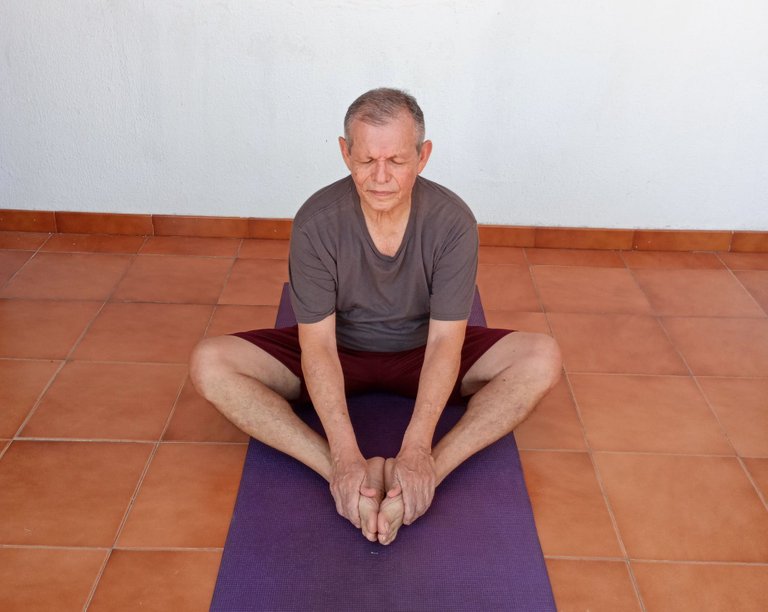
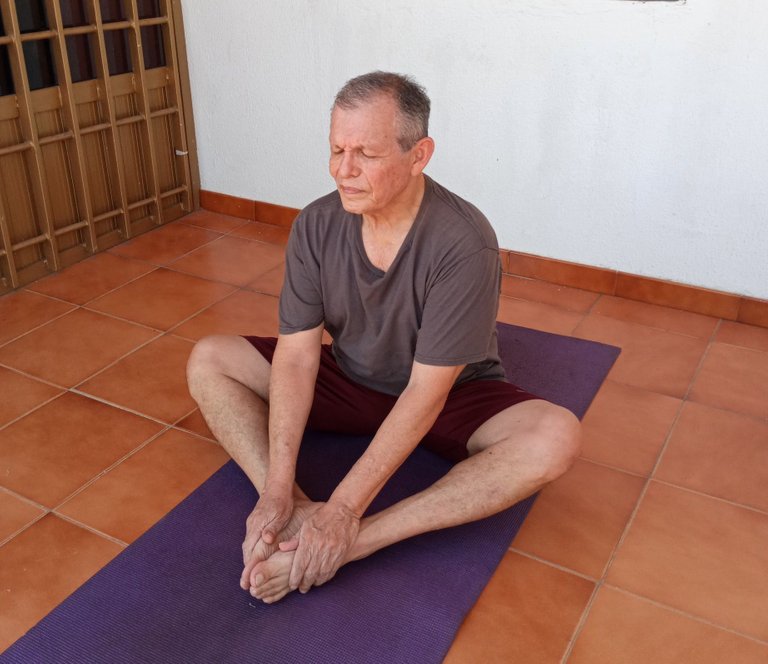
Meditation Process
It is an imperative, to comply with the meditation process, before warming up the body, in order to relax and calm the mind, on this occasion, we will meditate, forming the following posture; We will be seated with the back semi-flexed and the legs with the knees bent in front of the body, next, we join the soles of the feet, resting the hands on them, keeping the arms stretched, with this position we will reflect and interanalyze the following ideas:
1).-"An optimistic person senses an opportunity, in every calamity, while the pessimist pretends to observe a calamity, in every opportunity".
2).- "We have no power over external events, but we can control our minds".
3).-"When the mind is balanced, events are a challenge and when the mind is strong, every situation becomes an opportunity".
Ejercicios para el calentamiento corporal
Antes de hacer yoga, calentar el cuerpo tiene el propósito de alcanzar un buen rendimiento, evitar lesiones, flexibilizar los músculos y articulaciones, dicho calentamiento también lo desarrollaremos, con la finalidad de equilibrarnos e iniciar el fortalecimiento de los músculos de la espalda, del abdomen, de las piernas y los brazos, cumpliremos en el mencionado proceso doce minutos, descansando 10 segundos por cada dos minutos de ellos., los cuales son:
Parados con la espalda derecha, los pies separados a la altura de las caderas, las manos apoyadas en la cintura, despegamos el pie derecho de la esterilla, flexionamos la rodilla, levantamos la pierna del citado lado, apoyando la mano derecha en ella, luego extendemos la pierna derecha lateralmente.
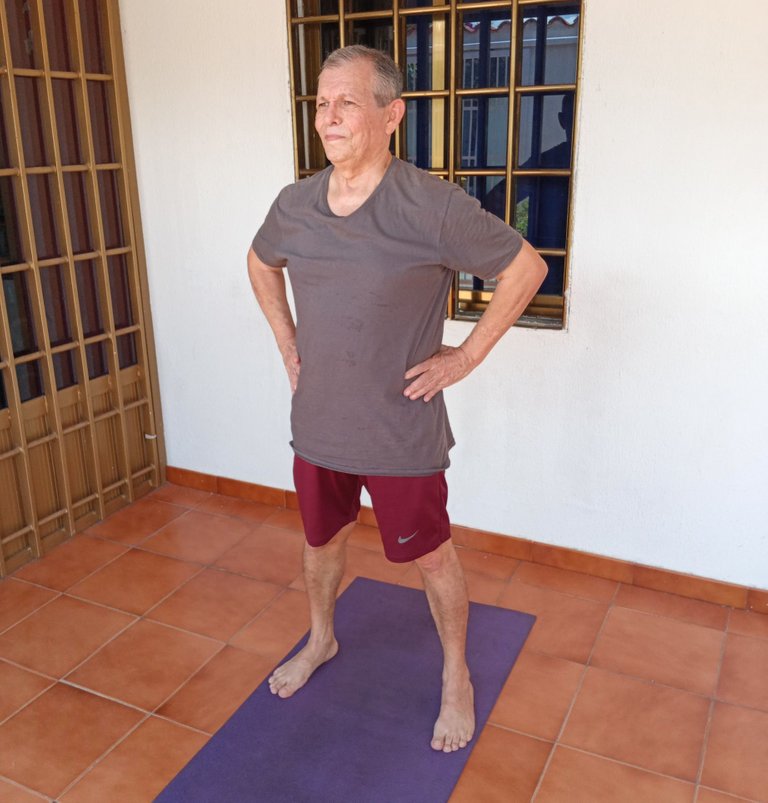
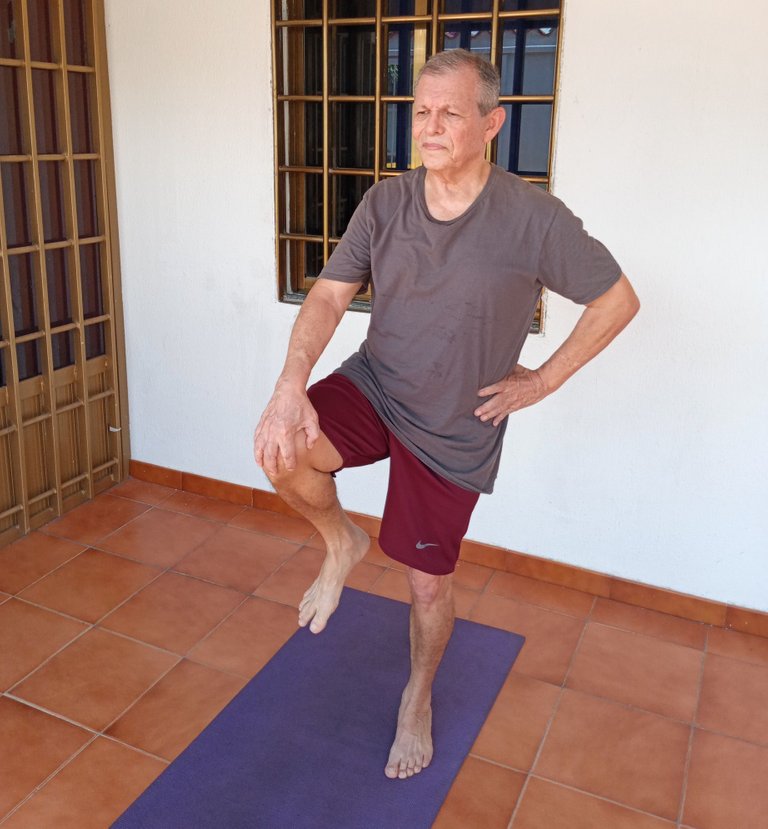

Exercises for body warm-up Before doing yoga, warming up the body has the purpose of achieving good performance, avoiding injuries, making muscles and joints more flexible, we will also develop this warm-up, in order to balance ourselves and start strengthening the muscles of the back, abdomen , of the legs and arms, we will complete twelve minutes in the aforementioned process, resting 10 seconds for every two minutes of them, which are: Standing with your back straight, feet hip-width apart, hands on your waist, take your right foot off the mat, bend your knee, raise your leg on that side, resting your right hand on it, then we extend the right leg laterally.
A continuación procedemos a continuar el ejercicio anterior, en esta ocasión levantando el pie izquierdo, doblando la rodilla de la pierna del citado lado, la cual extendemos lateralmente, manteniendo siempre el equilibrio.
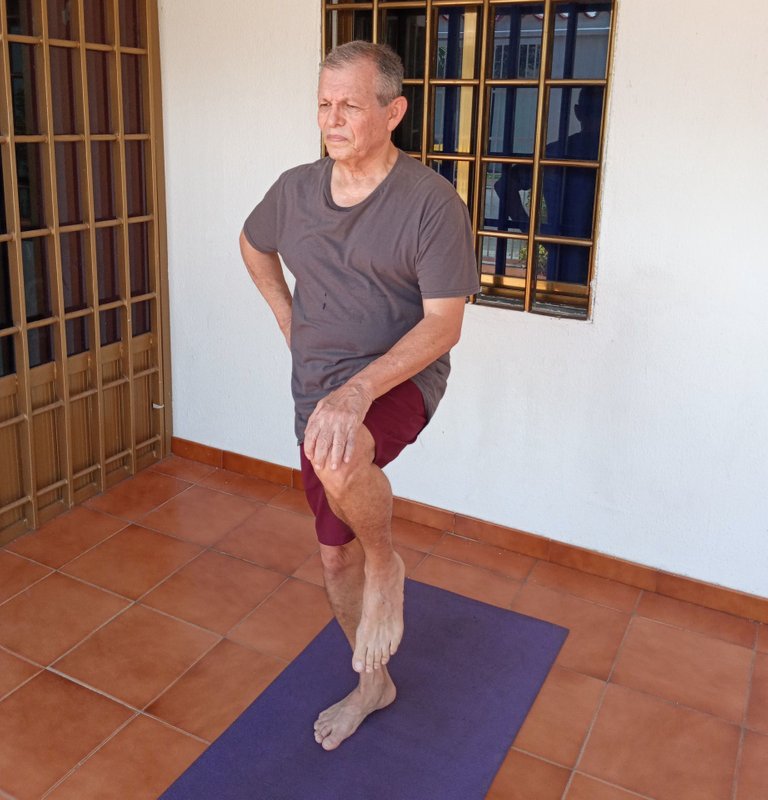
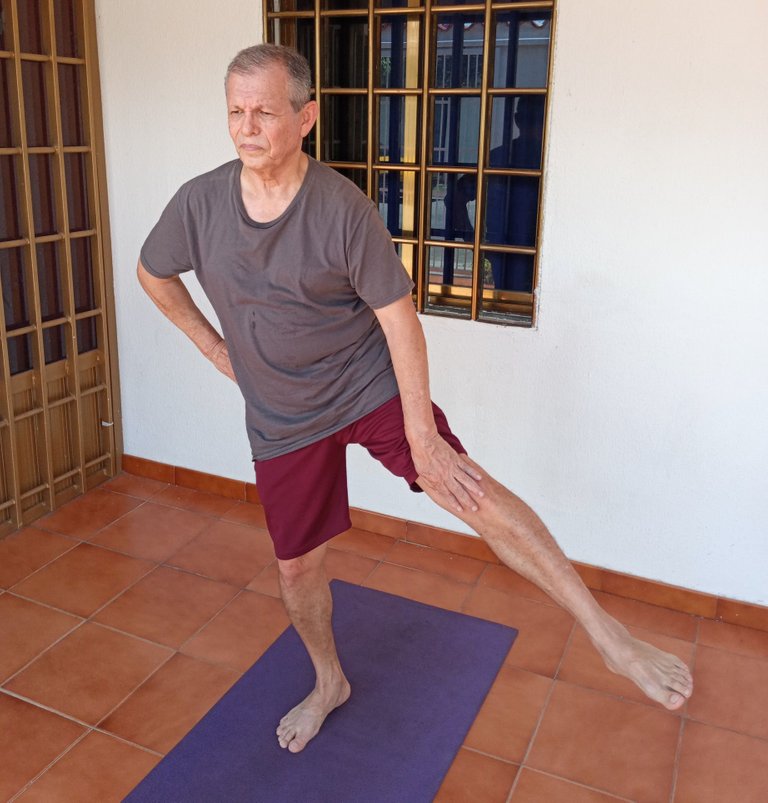
Then we proceed to continue the previous exercise, this time raising the left foot, bending the knee of the leg on that side, which we extend laterally, always maintaining balance.
Regresamos a la posición inicial, es decir parados con la espalda recta, despegando la mano derecha de la cintura para apoyarla en la rodilla de la pierna derecha, la cual extendemos al frente y luego la llevamos flexionada hacia atrás, tomando el pie con la mano derecha,
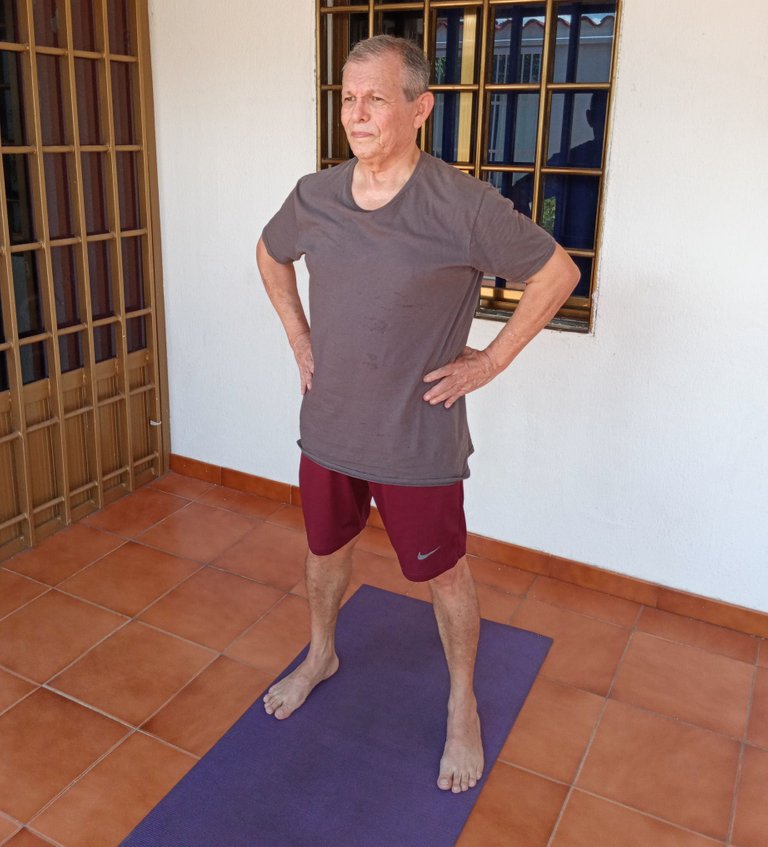
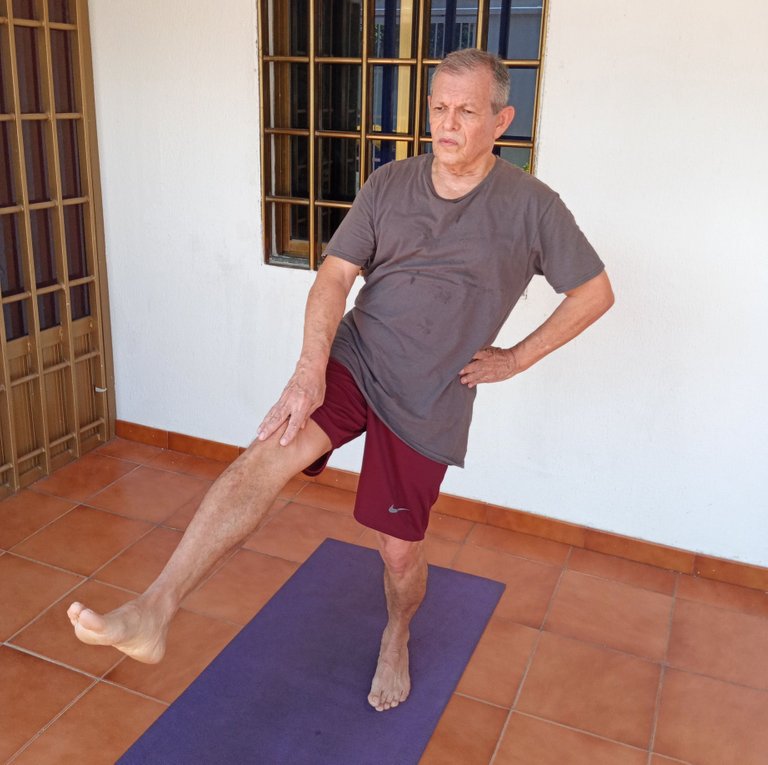
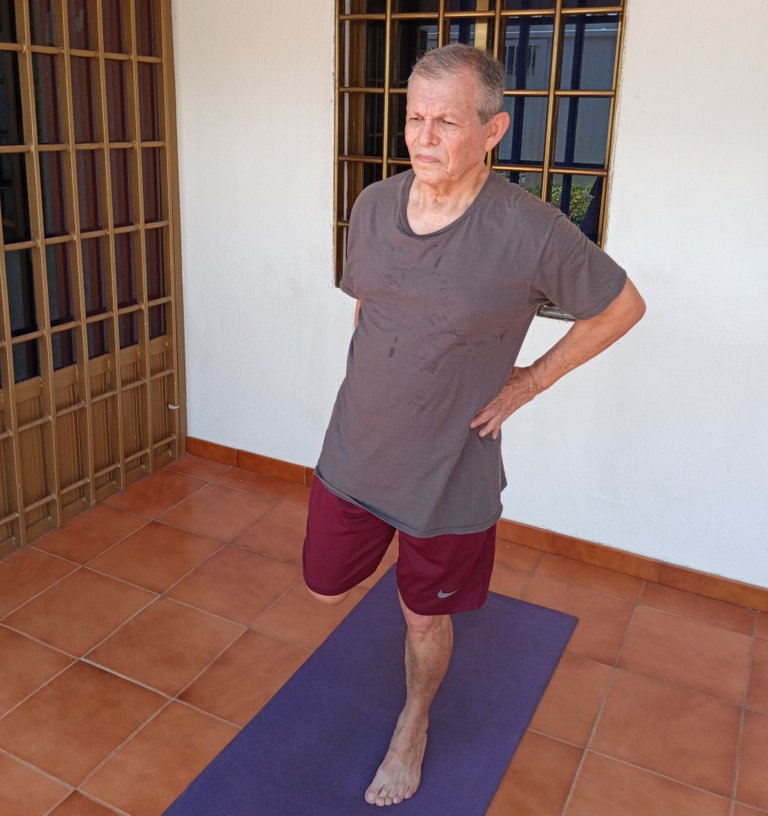
We return to the initial position, that is, standing with a straight back, taking off the right hand from the waist to support it on the knee of the right leg, which we extend to the front and then we take it flexed backwards, taking the foot with the hand right.
A continuación, aplicamos el mismo proceso, en esta ocasión, extendiendo la pierna izquierda al frente con la mano izquierda en la rodilla, seguidamente llevamos dicha pierna hacia atrás, doblándola para tomar el pie con la mano del mismo lado. Éxitos.
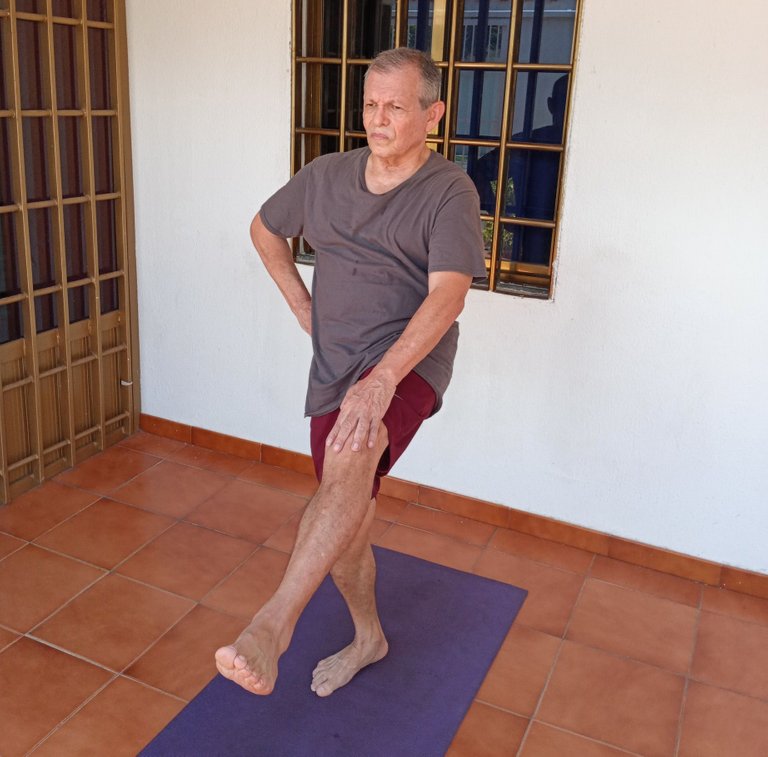
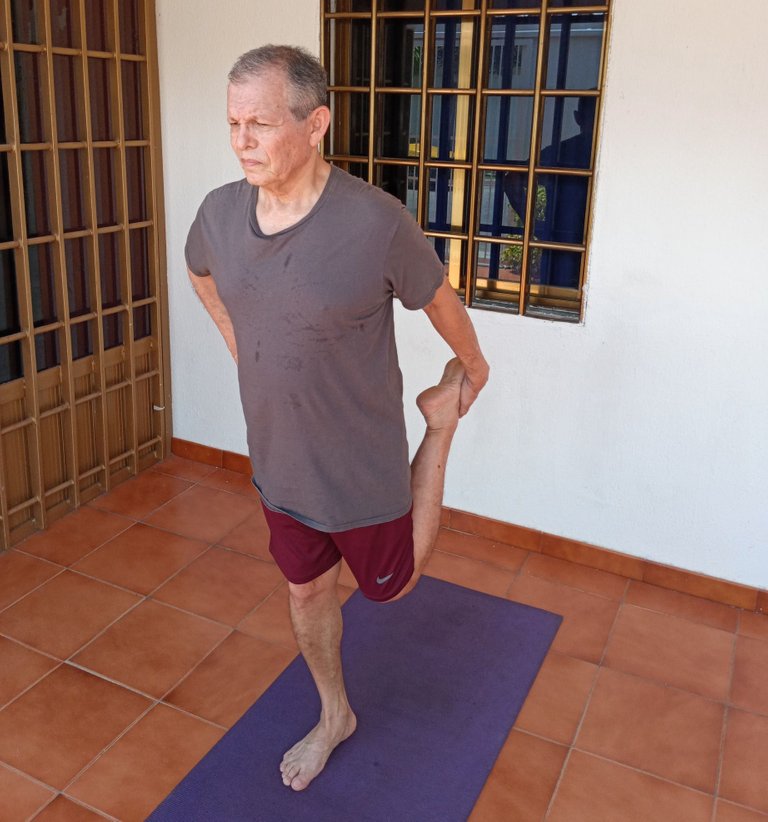
Next, we apply the same process, this time, extending the left leg in front with the left hand on the knee, then we bring that leg back, bending it to grab the foot with the hand on the same side. Successes.
Desarrollo de Ardha Purvottanasana o la postura de la mesa y sus variantes, levantando el cuerpo invertido, el cuello estirado, la mirada hacia arriba, los brazos extendidos con las manos en la esterilla, una pierna alzada la cual flexionamos, para colocar el tobillo y pie en el muslo de la otra pierna, cuyo talón del pie levantamos, es decir dejando apoyada en la esterilla la parte superior de la planta de dicho pie
Sentados sobre la esterilla, las piernas separadas con las rodillas flexionadas, los pies con los talones direccionados hacia la caderas, presionando las manos en la citada esterilla, a continuación, suavemente, vamos elevando la cadera a la altura de los hombros, alargando el cuello, con la mirado hacia atrás, si sientes algún malestar, logra pegar tu barbilla al pecho, si no ubícala conforme observas en la imagen, estando muy equilibrados, conformamos la asana Ardha Purvottanasana, estando en ella, permite que las manos y los pies, sostengan el peso del cuerpo, aunado a ello contrae los glúteos para fortalecerlos, al igual que debe ocurrir con los muslos y las piernas, reiterando la necesidad de seguir equilibrados y en resistencia corporal, duramos en la asana 30 segundos, inspirando, aguantando y expulsando aire. Éxitos.
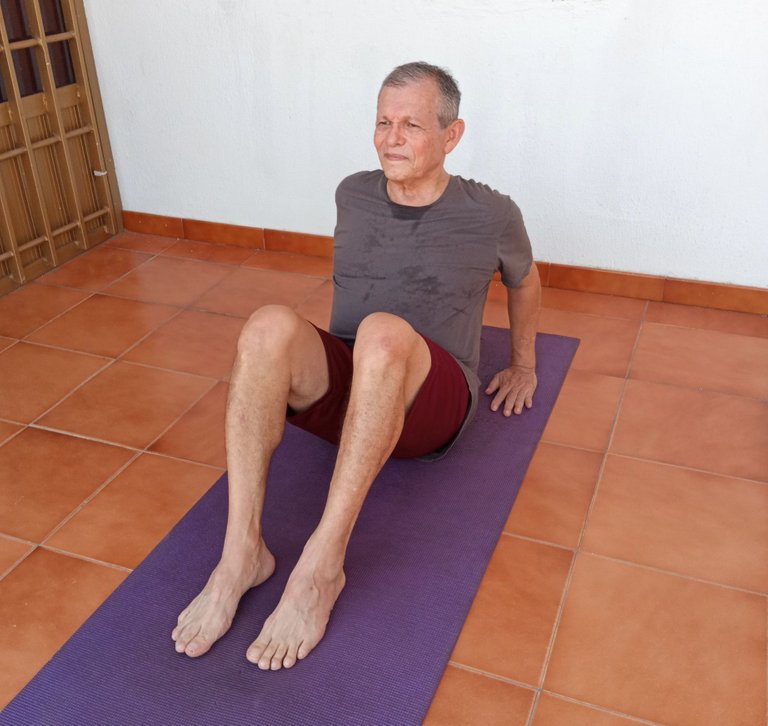
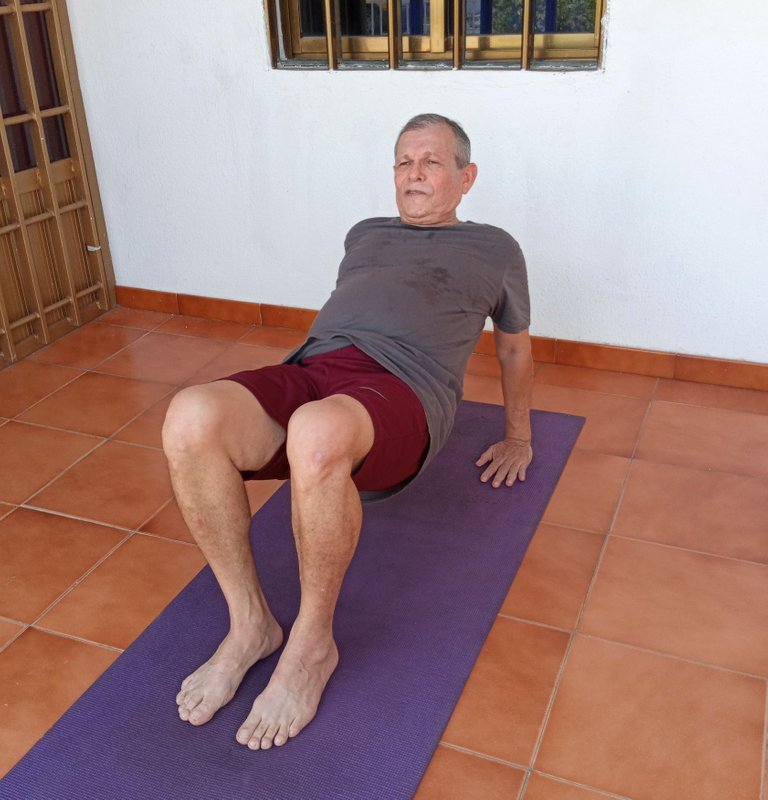

Development of Ardha Purvottanasana or the posture of the table and its variants, lifting the body inverted, neck stretched, looking up, arms extended with hands on the mat, one leg raised which we flex, to place the ankle and foot on the thigh of the other leg, whose heel we raise, that is, leaving the upper part of the sole of said foot resting on the mat
Sitting on the mat, legs apart with the knees bent, feet with the heels directed towards the hips, pressing the hands on the aforementioned mat, then, gently, we raise the hips to the height of the shoulders, lengthening the neck , looking back, if you feel any discomfort, manage to stick your chin to your chest, if not locate it as you see in the image, being very balanced, we form the Ardha Purvottanasana asana, being in it, allow the hands and feet, support the weight of the body, in addition to this, contract the buttocks to strengthen them, as should happen with the thighs and legs, reiterating the need to remain balanced and in body resistance, we last 30 seconds in the asana, inhaling, holding and expelling air. Successes.
Seguidamente, constituímos la primera variante de Ardha Purvottanasana o la postura de la mesa, estando equilibrados y en resistencia corporal, en la posición anterior, suavemente despegamos el pie derecho de la esterilla, levantamos y flexionamos la pierna derecha, colocándo el tobillo y pie en el muslo de la pierna izquierda, durando en dicha posición, 30 segundos inspirando, aguantando y expulsando aire. Éxitos.
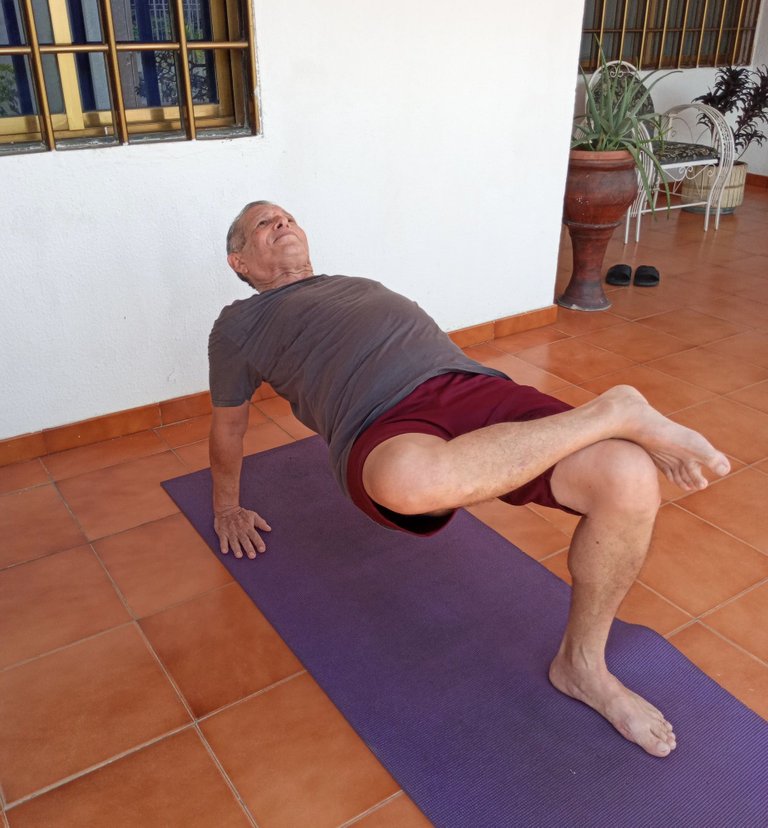
Next, we constitute the first variant of Ardha Purvottanasana or the posture of the table, being balanced and in body resistance, in the previous position, we gently take off the right foot from the mat, raise and flex the right leg, placing the ankle and foot in the thigh of the left leg, lasting in that position, 30 seconds inhaling, holding and expelling air. Successes.
A continuación conformamos la segunda variante de Ardha Purvottanasana o la postura de la mesa, estando equilibrados y en resistencia corporal, manteniendo el cuerpo invertido, apoyados de las manos, con la pierna derecha, cruzada y colocada encima de la pierna izquierda, procedemos muy suave y prudentemente, a despegar de la esterilla, el talón del pie de la pierna izquierda, para sostenernos solamente con la punta de la planta de dicho pie, durando en la citada posición 30 segundos, inspirando, aguantando y expulsando aire. Éxitos.
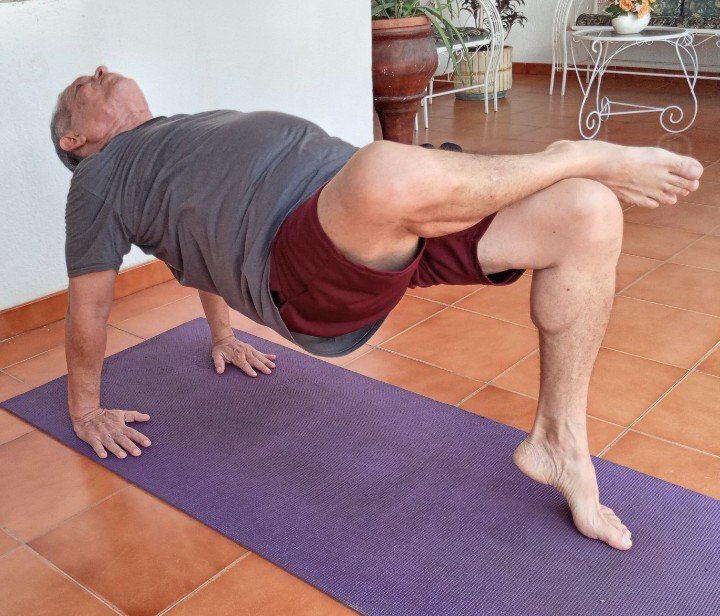
Next, we conform the second variant of Ardha Purvottanasana or the posture of the table, being balanced and in corporal resistance, keeping the body inverted, supported by the hands, with the right leg, crossed and placed on top of the left leg, we proceed very smoothly and prudently, to take off from the mat, the heel of the foot of the left leg, to support ourselves only with the tip of the sole of said foot, lasting in the aforementioned position for 30 seconds, inhaling, holding and expelling air. Successes.
Repetimos Ardha Purvottanasana o la postura de la mesa y sus variantes, de la siguiente manera, estando en esta ocasión con el cuerpo invertido, los brazos estirados, con las manos en la esterilla, cruzamos en está ocasión, la pierna izquierda encima del muslo de la pierna derecha, conformando la primera variante, seguidamente procedemos muy suave y prudentemente, a despegar de la esterilla, el talón del pie de la pierna derecha, para sostenernos solamente con la punta de la planta de dicho pie y lograr la segunda variante, durando en la posición 30 segundos, equilibrados y en resistencia corporal, inspirando, aguantando y expulsando aire. Éxitos.
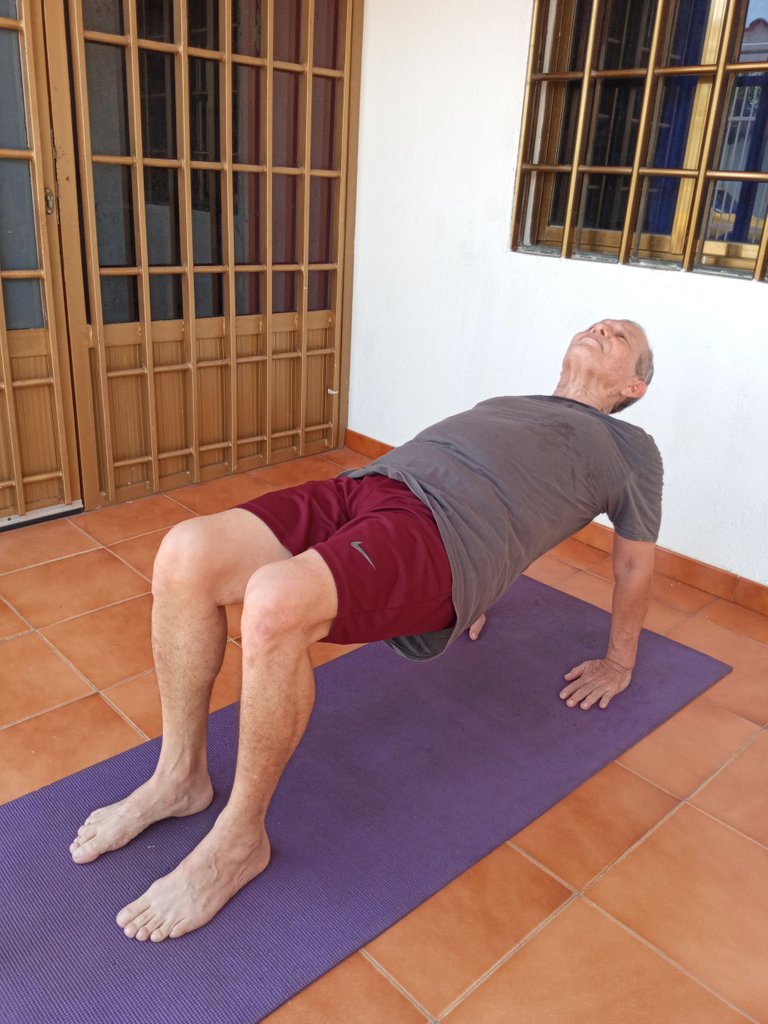
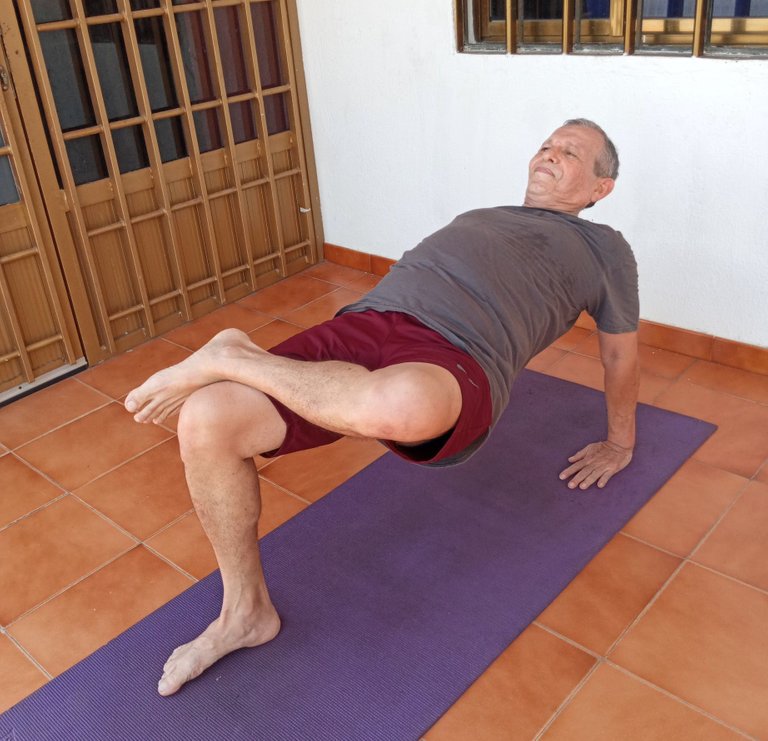
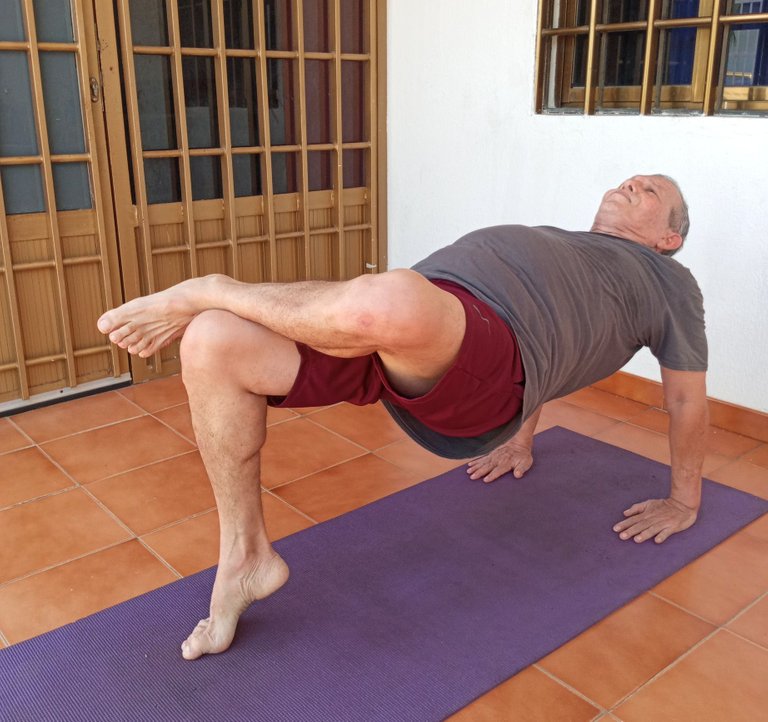
We repeat Ardha Purvottanasana or the posture of the table and its variants, in the following way, being on this occasion with the body inverted, arms outstretched, with hands on the mat, we cross this time, the left leg on top of the thigh of the right leg, forming the first variant, then we proceed very gently and prudently, to take off the heel of the foot of the right leg from the mat, to support ourselves only with the tip of the sole of said foot and achieve the second variant, lasting in the position for 30 seconds, balanced and in body resistance, inhaling, holding and expelling air. Successes.
Beneficios de Ardha Purvottanasana o la postura de la mesa y sus variantes, con el cuerpo invertido, el cuello estirado, una pierna cruzada encima del muslo de la otra pierna, cuya punta de la planta del pie se apoya en la esterilla
- Permiten alcanzar un cuerpo resistente, con músculos fortalecidos.
- Generan un entrenamiento intenso de la parte delantera del cuerpo.
- Son muy energizantes.
- Fortalecen los músculos de los glúteos, los hombros, el cuello, las muñecas, las piernas, los brazos y la espalda.
- Benefician los sistemas circulatorios,respiratorios y digestivos.
- Relajan el sistema nervioso.
- Calman la mente y alivian la ansiedad.
Benefits of Ardha Purvottanasana or Table Pose and its variations, body inverted, neck stretched, one leg crossed over the thigh of the other leg, the sole of the foot resting on the mat
- They allow to achieve a resistant body, with strengthened muscles.
- They generate an intense training of the front part of the body.
- They are very energizing.
- Strengthen the muscles of the buttocks, shoulders, neck, wrists, legs, arms and back.
- They benefit the circulatory, respiratory and digestive systems.
- Relax the nervous system.
- Calm the mind and relieve anxiety.
Ardha Purvottanasana o la postura de la mesa y sus variantes, con el cuerpo invertido, los brazos estirados con las manos presionando la esterilla, la mirada hacia arriba y una pierna cruzada encima del muslo de la otra pierna, cuya punta de la planta del pie se apoya en la citada esterilla, son asanas muy importantes y necesarias, para alcanzar un cuerpo resistente, con músculos fortalecidos, igualmente generan un buen entrenamiento intenso de la parte delantera del cuerpo, imprimiéndole mucha energía, permitiendo también el efectivo fortalecimiento de los músculos de los glúteos, los hombros, el cuello, las muñecas, las piernas, los brazos y la espalda. Las estudiadas asanas, son muy recomendadas para beneficiar los sistemas circulatorios, respiratorios y digestivos. Tan distinguidas asanas, también son muy adecuadas para relajar el sistema nervioso, calmar la mente y aliviar la ansiedad. Amigos, al agradecerles su receptividad y continuas visitas, me suscribo a ustedes, con mucho entusiasmo y afecto. Omar Gustavo Rojas Ortiz desde la ciudad de Cumaná en el estado Sucre-Venezuela.
Ardha Purvottanasana or the posture of the table and its variants, with the body inverted, the arms stretched out with the hands pressing the mat, the gaze upwards and one leg crossed over the thigh of the other leg, the tip of the sole of the foot rests on the aforementioned mat, they are very important and necessary asanas, to achieve a resistant body, with strengthened muscles, they also generate a good intense training of the front part of the body, giving it a lot of energy, also allowing the effective strengthening of the muscles of the back. buttocks, shoulders, neck, wrists, legs, arms, and back. The studied asanas are highly recommended to benefit the circulatory, respiratory and digestive systems. As distinguished asanas, they are also very suitable for relaxing the nervous system, calming the mind and relieving anxiety. Friends, in thanking you for your receptivity and continuous visits, I subscribe to you, with great enthusiasm and affection. Omar Gustavo Rojas Ortiz from the city of Cumaná in the state of Sucre-Venezuela.
Las imágenes fueron tomadas por Nancy de Rojas con mi celular Samsung Galaxy A10s y la publicación es de mi autoría.
The images were taken by Nancy de Rojas with my Samsung Galaxy A10s cell phone and the publication is my own.
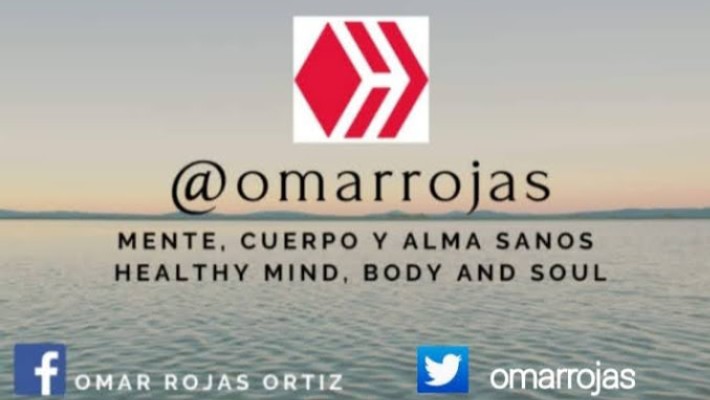
https://twitter.com/Omarroj52318483/status/1562112115695132675
https://twitter.com/metodologiaecs/status/1563334781667946497
The rewards earned on this comment will go directly to the people( @pedrobrito2004 ) sharing the post on Twitter as long as they are registered with @poshtoken. Sign up at https://hiveposh.com.
Excelentes posturas, como dijiste, Equilibrio, Control del Cuerpo y Consciencia Corporal. 3 puntos importantísimos para trabajar y conocer nuestra materia!
Felicitaciones por el post! 👏
Gracias estimado, espero practiques las tres etapas, meditación, calentamiento y las posturas, son muy energizantes, al principio puedes lograrlas como el puente, es decir con apoyo de hombros y los brazos a los lados, luego con el estiramiento de los brazos y apoyos de las manos, para la postura indicada de la mesa y sus variantes. Gracias por su visita y acertada opinión. Éxitos
Siempre es un placer ver sus excelentes rutinas de yoga, usted es el maestro acá en esta comunidad como referente de la práctica del yoga, jamás había visto una personas con tantas rutinas y que estás sean diferentes una de otra, simpre innovando estimado. Por ello es el mejor en este ramo del ejercicio o práctica del yoga.
Quiero expresarle mis respetos y mi asombro con la calidad de sus rutinas. Un abrazo amigo querido un placer haber visitado su post.
Gracias estimado amigo @edmundochauran sus palabras me motivan mucho, a seguir creando posturas, ciertamente usted puede evidenciar en muchas literaturas sobre yoga, algunas posturas muy comunes, las cuales me permiten profundizarlas, con esto no quiere decir que sean más complicadas y no se puedan ejecutar, sino para que las personas le pongan más entusiasmo y no se encasillen en las asanas comunes, y esto es el yoga la creatividad y que de acuerdo a la flexibilidad y constancia de cada persona, incluso acorde a la edad, podamos innovar ejercitaciones. La postura la mesa es un ejemplo clásico, donde se ha podido crear posiciones para bien de nuestra salud física y mental. Sus palabras, realmente están cargadas de mucha simpatía por lo que hago, como siempre, continuaré deseándole muchos éxitos hermano.
Vaya mi buen amigo. Esto que usted hace es único. Siempre he pensado que sus post están presentados de una manera tan pulcra que impresiona. Esto es como que estuviese leyendo en una revista deportiva. Sin lugar a dudas y excelentísimo trabajo.
Exitos.
Gracias estimada amiga @artsugar su opinión me motivan a seguir desarrollando mis publicaciones con mucho entusiasmo. Éxitos